How to build a fence on a slope with concrete posts
The most important thing to remember while fencing on a slope is to avoid trying to follow the curve of the ground with your fence posts and panels, since this will result in an unstable appearance. Ignore the ground’s slope and work with accurate uprights and horizontals for a professional looking finish. The posts are excavated and concreted much like a fence on flat terrain, but the top of the fence panel must remain level. If the top of the fence panel is slanted, the post must likewise be slanted, which is unsightly. If the slope is moderate, the soil can smooth out the difference in level at the fence’s base. Instead of having enormous gaps beneath the panels where the slope is steeper, dig out portion of the slope and drop the end of the panel into the “trench,” so that the grass or flowerbed near to the fence has a smooth curve.
Use the Slope to your advantage
You may then experiment with the top level of your fence as long as the fence posts and rails are upright and level. If you’re erecting a close board or palisade fence, for example, you may mimic the land’s line by making each board the same length and distance from the ground.
Stepped Fence Installation Tools and Materials
Posts for fences
- Fence panels or boards and rails if you’re constructing a close board fence
- Gravel boards
- A fence post auger, a spade, or a post whole digger if the ground is soft enough.
- A level of spirit and/or a post-level
- Masonry line
- Quick-setting fence post concrete
- For the concrete mix, a bucket, a watering pail, or, better yet, a hose pipe
- Fill each post hole with aggregate.
- Batten and other wood offcuts for creating a line and supporting the fence posts while the concrete sets
- Brush and a wood preserver
- Using a string line between posts, mark out your fence’s line. If your fence is on the property line, verify the house’s title documents to make sure you’re not intruding on someone else’s land.
- Determine what materials you’ll need by measuring the length of your new fence. Fence panels are typically 6 feet wide despite the fact that the United Kingdom uses metric measures, we still use feet for our fence panels. As conventional heights, they are 6 feet, 5 feet, and 4 feet. You may build close board fence to any height you like.
- Dig the first hole; if your first panel butts up against a home or outbuilding wall, you can attach the first post and panel to that wall, as digging a hole for a fence post that near to the foundations is doubtful. For more information on how to acquire a secure fix, see our masonry mending project.
- Cover the hole’s bottom with a layer of aggregate.
- Insert the post into the hole and use a spirit level or a post level to verify for levelness in both directions. Support the post on either side with some wood after it is in place.
- Pour in mixed concrete or water and Postcrete or equivalent product into the post hole, following the manufacturer’s directions. Learn how to utilize Postcrete in this project for fence.
- Double-check that the panel and post are still level, and make any required adjustments. Depending on the ambient circumstances, the Post should go off in roughly 15 minutes.
- You can dig a second fence post hole while the concrete in the first hole cures. Six feet away and on your indicated line, measure for the next hole. The first hole’s concrete should have hardened by the time you dig the second hole.
- Attach a fence panel to the first post and make sure it’s straight and level.
- Place a post in the second hole and secure the first fence panel to it, making sure it is straight and level. Secure the second post on either side with some lumber after the first is in place.
- Fill the second hole with cement.
- Continue until your fence reaches the end. Make sure you stay on your line at all times, and once you’ve gone as far as you want to go in a day, double-check that every post and panel is plumb.
- If you need to cut down a fence panel to make it fit at the end, we have a project on how to cut down a fence panel that will show you how to do it correctly unless you are lucky, you are very likely to have to do this. It might be difficult to properly install fence panels such that they are level and upright.
Fencing tips for a beautiful ending
- Keep your fence in good condition.
Any section of the fence panel should not be buried since it will quickly decay. Gravel boards have been installed between the posts, as seen in the illustration.
- Make a clean line.
Always remember to utilize a string line with your fence, as illustrated in the project on fencing to flat land.
- Make sure you have the appropriate levels.
Use a post level to make sure the fence posts are plumb, and a spirit level to make sure the top of the fence is level and double-check as you go.
- Make use of a fence post concrete that sets quickly.
Digging holes for fence panels as you go is significantly easier, and we always advocate utilizing Postcrete to do it successfully or other similar products)
- Obtain sufficient supplies.
Make sure you have enough resources to complete the work in the time allotted – nothing is more unpleasant than running out of materials in the middle of a project.

